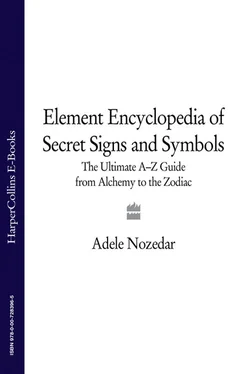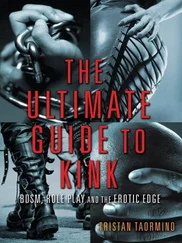If the cube is unfolded, it turns into a cross; this cross gives us the standard floor plan of Christian churches and further reinforces the idea of stability and eternity.
One of the five Platonic solids and one of the Tattvas, the cube represents the element of Earth.
This is a small doll intended to resemble the founder of Zen Buddhism, the Bodhidharma Daruma. Daruma brought the teachings from India to China in the sixth century. The dolls are ubiquitous in Japan as a good-luck symbol par excellence as well as a reminder of the need for patience.
The dolls are rounded and chunky, reflecting the story that the Bodhidharma spent such a long time (reputedly nine years) meditating motionless in a cave that his limbs atrophied. A weight inside the base of the rotund little figure means that it may wobble but it never falls over, and this feature symbolizes Daruma’s persistence in his meditative process as well as illustrating the Buddhist tenet that you can fall over seven times but still get up again on the eighth. He was so zealous that he is even reputed to have cut off his eyelids so that he could not fall asleep, and this is why the dolls also have wide, staring eyes. Coincidentally, the gift of tea was given to Daruma by God to help him keep awake.
Given as a gift at the New Year, each of the eyes of the Daruma doll are colored with a marker when certain goals are achieved. When both eyes are colored the little doll is burned on a shrine as an offering.

A relatively new sign, the dearinth was invented by Oberon Zell as the symbol for his Church of All Worlds. Zell is credited with inventing the term “Neo-Pagan.” The symbol represents a labyrinth but also cleverly includes the figure of the God and Goddess. The nine concentric circles of the dearinth relate to the nine levels of initiation within the Church.
Witches and wizards might write their names, followed by a symbol that denotes the level of his or her initiation into the Craft.
FIRST DEGREE [INVERTED TRIANGLE]

This shows the neophyte that has been introduced to the most basic teachings and traditions. The shape of this inverted triangle is also drawn in the air as the “threefold salute,” and is drawn in the sequence of breast, breast, genitals, breast.
The second stage of witchcraft, and a deeper level of knowledge is also represented by a gesture that emulates the shape of the upright triangle; mouth, breast, breast, mouth.

The Fivefold Salute describes the shape of an inverted pentagram by tracing a line from genitals to right breast, then left hip to right hip, right hip to left breast and back to genitals.

This is the sign used by fully fledged witches and wizards. Formed of a pentagram surmounted by an upright triangle, it is traced in the air from mouth to breast, then back to the mouth, genitals, right foot, left knee, right knee, left foot and back to the genitals.
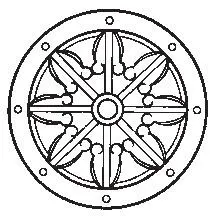
The Dharma wheel or Dharmachakra is used as a symbol in both Hinduism and Buddhism. It is an eight-spoked wheel, sometimes rendered quite decoratively. Each spoke of the wheel represents one of the pillars of belief that applies to these Dharmic religions.
1 Right faith
2 Right intention
3 Right speech
4 Right action
5 Right livelihood
6 Right effort
7 Right thought
8 Right meditation
The wheel symbol in general is complex and is covered elsewhere; this particular wheel represents the notion of overcoming obstacles, difficulties, and challenges.
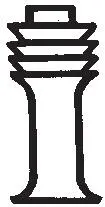
An Ancient Egyptian symbol of stability, the djed is an image of a pillar with four platforms piled on top of it. As with other pillar-like symbols the world over, the djed also signifies the World Axis, the World Tree, and the phallus.
The simple doorway—an everyday object that goes unnoticed most of the time—is symbolic of a transition between one world and the next. Such a doorway may take different forms, as a dolmen, a torii, a gateway, but the meaning remains the same. In C. S. Lewis’s Narnia novels, the wardrobe into which the children step to enter the magical world of Narnia is a good example of this symbol. Both Heaven and Hell lie beyond gates or doorways, and the threshold of such a place is seen as the place where two worlds meet and sometimes collide. Many rituals involve the initiate stepping through a doorway of some kind. The vesica piscis represents a doorway where the world of spirit enters the world of matter.
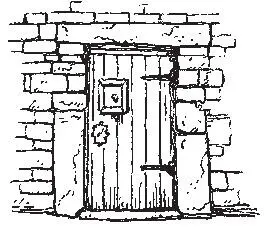
See Vajra.
See First signs: Dot.
This good-luck symbol, ubiquitous in China or in places where there is a strong undercurrent of Chinese culture, comprises the character meaning happiness, written twice, hence the name, Double Happiness. The meaning of the sign is inferred in its name, and it is a popular symbol for practitioners of Feng Shui. The sign is effective if placed in the sector of the home that relates to relationships. It is also said to be particularly lucky for newlyweds.
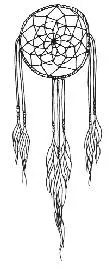
The forerunner of the Dreamcatcher was a Native American spider’s web of feathers and beads, a simple little charm made from a small hoop of flexible wood, such as willow, with an interlacement of plant fibers designed to look like a cobweb.
This little amulet was used particularly as a protection for babies and small children. Hung over their cradles and beds, it was thought to entrap any negative spirits that came in the form of nightmares. These malevolent entities, entangled in the web, were sizzled in the heat from the rising Sun. The spider’s-web shape gave homage to Asibikaasi, the mythical Spider Woman, whose magical webs could catch anything.
Читать дальше
